Sciatica is pain, numbness, or tingling down the back of your leg that originates in your back and travels down your leg. Oftentimes exercising and moving in certain ways can help to minimize these symptoms. This is a progression of the best physical therapy exercises to help you treat your sciatic nerve symptoms.

(Below we’ll discuss sciatic nerve pain as related to the most common cause – a bulged or herniated disc. If your sciatica is coming from a different source, this may not be the best exercise progression for you. You’re encouraged to consult with your doctor or physical therapist for an individualized treatment plan.)
Best Exercises For Sciatic Nerve Pain
- Lay prone on your stomach – extension and gravity help bulged disc material back into the center.
- Prone on elbows – as your tolerance allows, lay on your stomach and prop up onto your elbows.
- 1/2 Prone press up – lay on your stomach, keep your hips on the floor, and press with your hands until your elbows are halfway straight.
- Full prone press up – lay on your stomach, keep your hips on the floor, and press up onto your hands fully extending your elbows.
- Standing back bend – stand up and bend over backwards as far as you can per your tolerance
Keep reading below for video demonstration and full picture/text descriptions of each exercise.
As a doctor of physical therapy, spine injuries are the most common condition that I treat.
It seems like at one time or another low back pain or neck pain inflicts all of us. To a degree, almost all of us will experience some degree of low back or neck pain.
Depending on the cause of your low back pain, you may experience the accompanying symptom of sciatica. This is characterized by pain/numbness/tingling down the back of your leg. It can travel to your glute, hamstring, or (in more severe cases) down into your calf and ankle.
Today I wanted to share with you the best exercises for treating sciatic nerve pain. This method of treatment is it clinically proven and backed by dozens of research studies to be the most effective exercise treatment for a common cause of sciatic nerve pain.
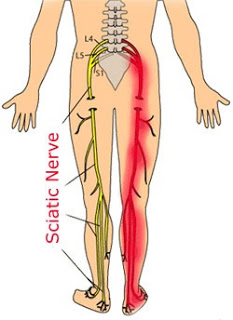 What is sciatica?
What is sciatica?
Sciatica is a term used to describe pain, numbness, or tingling along the sciatic nerve. Your sciatic nerve is actually a collection of three large nerves wrapped in a common sheath that travels down the back of your leg. These nerves originate in your lower back, come together to form the sciatic nerve in the back of your hip, and travel all the way down to your foot. It’s these nerves are responsible for most of the sensation and muscle activity in your legs. Sciatica is usually caused by some sort of irritation to these nerves.
What causes sciatica?
There are actually many different diagnoses which can cause sciatic nerve pain. These include a bulging disc, stenosis (narrowing of the canal through which the nerve passes), inflammation, or other musculoskeletal irritations to the nerve.
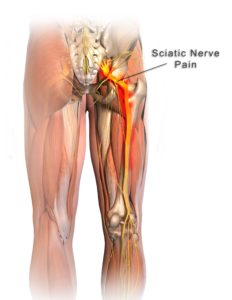 Why does my leg feel symptoms when my back hurts?
Why does my leg feel symptoms when my back hurts?
“Sciatica“ is actually not a diagnosis – rather it is a symptom of a different problem. Your leg feels pain/numbness/tingling because of a problem that originates in your back. Whatever the cause of your pain, be it a disc, stenosis, inflammation, etc., this can perturb your sciatic nerve up in your lower back which results in the altered sensation down in your leg.
Today I wanted to share with you the best exercise progression to treat sciatica originating from one very specific problem – a bulging disc. Before we get into this, I wish to stress that not all back pain is created equally. As mentioned above, your sciatic nerve symptoms can be coming from multiple causes. It’s important that you consult with your physician or physical therapist to determine what exactly is the cause of your back pain/sciatic nerve symptoms so as to determine the best individual treatment for you.
What is a bulged or herniated disc?
In your back, your vertebrae are stacked one on top of the other in a boney column. Between each one of these bones you’ll find a cartilaginous “disc“. These discs allow for compression/shock absorption during activity as well as provide us with many degrees of motion available at our back.
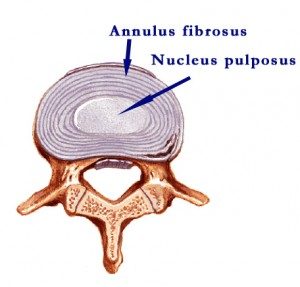 Our discs are made up of primarily two substances. There is a very strong outer “shell” made of really tough fibrous cartilage called the anulus. The inner part is made of a gelatinous, liquid substance which is called the nucleus.
Our discs are made up of primarily two substances. There is a very strong outer “shell” made of really tough fibrous cartilage called the anulus. The inner part is made of a gelatinous, liquid substance which is called the nucleus.
In a bulging disc, the liquid nucleus center pushes out into the cartilaginous annulus layer. Most often the result is you have disc material taking up space that it normally did not take up before. Often times if this “bulging disc“ impinges on a nerve as it exits your spinal cord, the results can be sciatica or sciatic nerve pain/symptoms.
How do I treat a bulged or herniated desk?
In most cases, our discs bulge posteriorly (towards the back). A posteriorly bold disc is most often caused by flexion (forward bending) activities.
In order to counter these effects, the recommended treatment is typically to promote extension (backward bending) motions/activities. The goal is to take that disc material that is bulging posteriorly and to help push it the other direction, back to the center of the disc where it belongs.
What is centralization versus peripheralization?
One more important caveat to mention – that is the idea of centralization versus peripheralization. Any movement or activity that causes the sciatic pain/numbness/tingling in your leg to decrease or creep up closer to your lower back is a good thing. Those are the types of motions and progress that we want to promote. Conversely, anything that you do that causes your pain/symptoms to increase in your leg or further down your leg means that we are exacerbating the problem. Those are motions we want to avoid.
Remember – a decrease in numbness/tingling in your leg and moving these symptoms closer to your back is a good thing. An increase in pain/numbness/tingling or symptoms further down your leg is a bad thing.
There are different phases to this progression. You should start at the first phase and sequentially progress to the next as per your pain/symptom tolerance.
![]()
BEST EXERCISE FOR BULGED DISC WITH SCIATICA
PHASE ONE: LAYING PRONE ON YOUR STOMACH
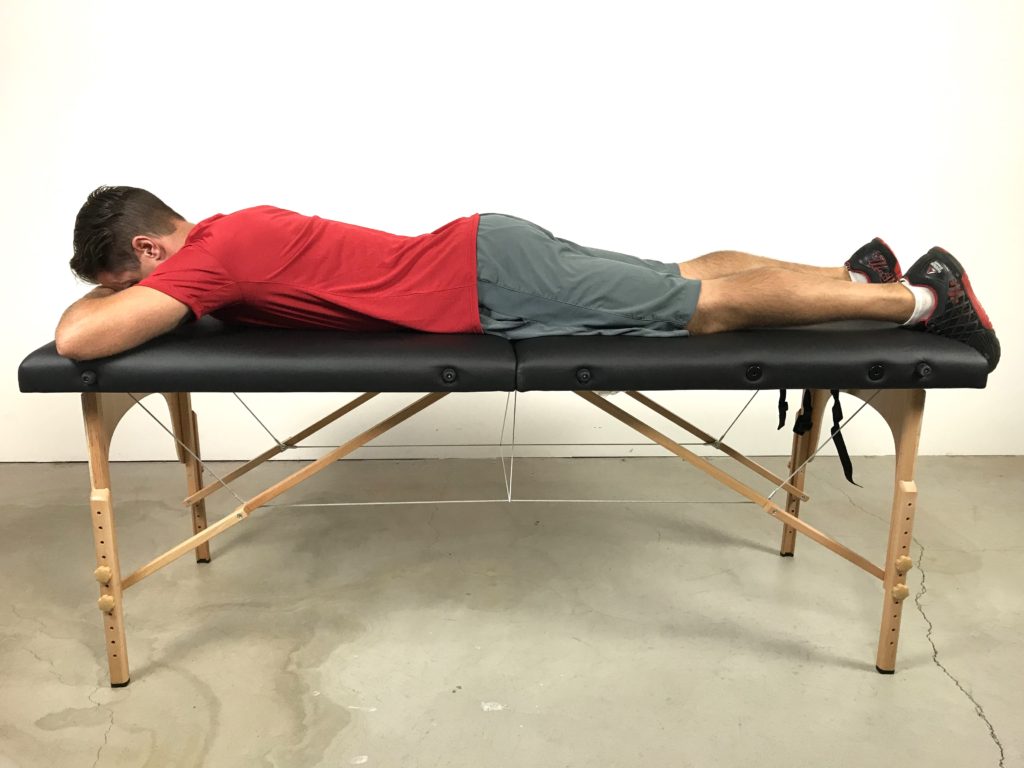
The simplest way to promote extension through your spine is to lay down prone on your stomach. This will create a natural curve to your back and vertebrae which will push the disc in the right direction. Gravity also works on the disc in this position to draw it closer to the center.
I recommend people start here until they can lay in this position for 2–3 minutes. When this becomes comfortable and there is no increase in your sciatic nerve symptoms, progress to Phase 2.
PHASE TWO: PRONE ON ELBOWS
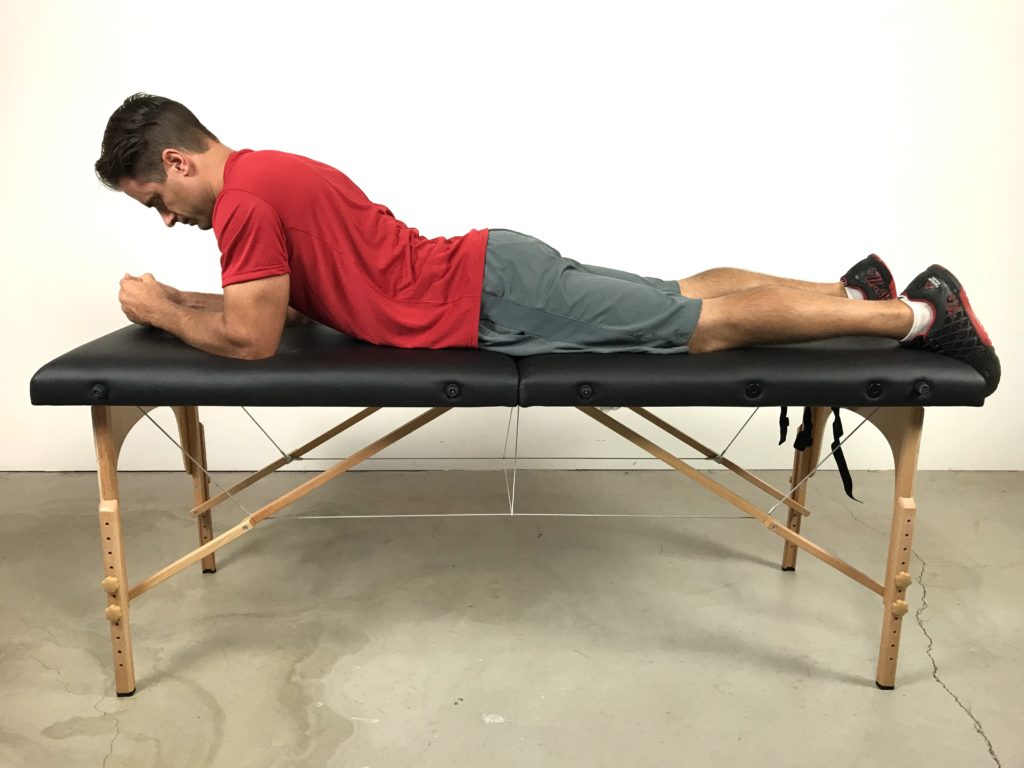
Bring your elbows directly under your shoulders and lift your chest up off of the floor. Your hips/stomach should stay in contact with the floor. In this position we promote increased extension through your lower back and draw the disc a little more aggressively back in the place.
Hold this position on your elbows for about 10 seconds, then lower your chest back down to the floor for 10 seconds, then repeat. This prone on elbows extension activity should be repeated 10 times for 10-second holds two times a day.
When prone on elbows becomes comfortable and there is no increase in your leg symptoms, progressed to Phase 3.
PAHSE THREE: HALF PRONE PRESS UPS
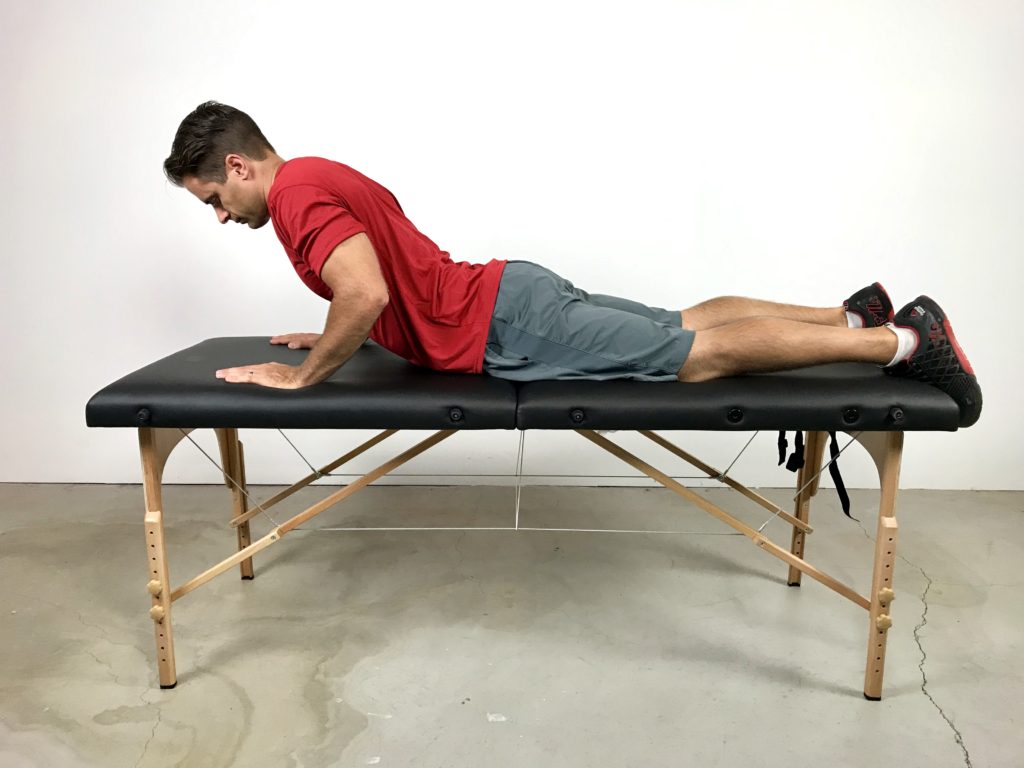
Now bring your hands directly under your shoulders. Lift your chest up off of the floor by extending your elbows approximately halfway. Once again, your goal is to keep your stomach and pelvis in contact with the floor and promote extension through your lower back.
Hold this position for 10 seconds and then return to the full prone position with your chest on the floor. Rest 10 seconds and then repeat.
Perform 10 reps of 10 second-holds two times daily.
When Phase 3 becomes comfortable with no increase in symptoms in your legs or pain in your back, progress to Phase 4.
PHASE FOUR: FULL PRONE PRESS UPS
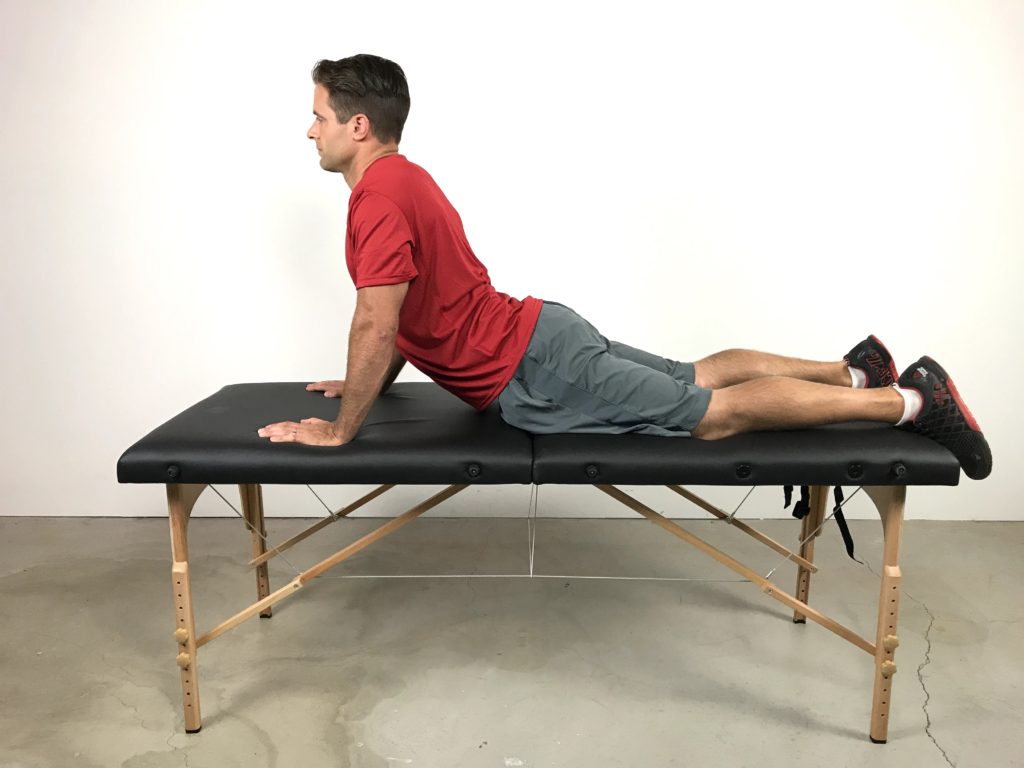
A full prone press up is performed in a similar manner to the half press-up; the difference now is that your goal is to fully extend your elbows. Try to keep your pelvis/stomach in contact with the floor as your extend your elbows fully and raise your shoulders as high as they can go.
Perform 10 reps of 10 second-holds two times daily.
When Phase 4 becomes comfortable with no increase in symptoms in your legs or pain in your back, progress to Phase 5.
PHASE FIVE: STANDING BACK BEND
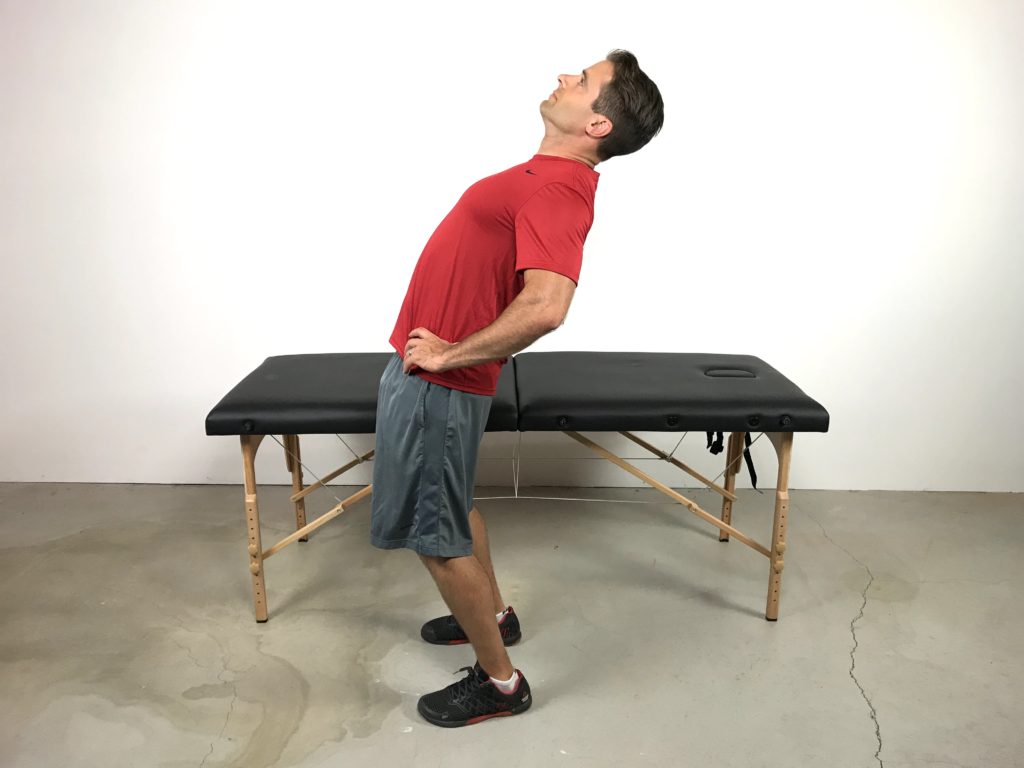
The standing back bend is performed by leaning over as far as you can backwards from a standing position. This is a little more aggressive than those I previously showed because it is in a weight-bearing posture and you do have to engage some muscles to keep from falling over. However, this is a great exercise to work some of your disc material back into place and minimize those sciatic nerve symptoms.
Try holding this position for 5 seconds, come forward for 5 seconds, and then repeat that 10 times.
![]()
Sciatic nerve symptoms can be very painful, annoying, and limiting.
Properly treating them with the right exercises at the right time can be a very effective, non-invasive form of treatment for these symptoms.
I hope you found this information beneficial and that you get some relief from your symptoms.
If you have any questions please leave them for me in a comment below.
Neck pain and tension headaches? Here’s another one of my videos you may find useful!
Also, I’ve got an entire blog post series dedicated to helping your with some of the most-common forms of injury I see in my clinic. Check some of these out, too!
Be sure to follow Tone and Tighten on YouTube | Facebook | Instagram | Twitter | Pinterest
Make it happen,
Jared
Disclaimer: The information presented in this post is designed to be used for informational purposes only. The diagnoses and treatment plans outlined are extremely generalized and may or may not be the recommended interventions for your specific problem. If you are experiencing pain, you are encouraged to consult a healthcare provider to determine the best treatment plan that will be in your best interest individual. Tone and Tighten claims exemption from accident, injury, or perpetuation of any injury incurred while performing any exercise found on this website. The user assumes all risk … and reward !!

Hi
I watched some of your videos on YouTube and they are very helpful with the pain I’m experiencing. I will like to forward my MRI SCAN report to you if possible. If you can please review the results of the report and guide me to the proper forms to go about easing my pain away.
Hi Sarah. Thanks so much for watching my video and commenting, but what you’re asking is outside the scope of free treatment and would constitute a personal professional consultation. I would need to charge you for that. I would encourage you to consult with a local doctor or physical therapist to determine a treatment plan that will be best for you. Sorry, and good luck!
Can these exercises be done even though you have had a back op and would you re ommend water exercising like ie treading water with knees coming ip high and frog leaps. Thank you so much
Depends on what kind of back operation, Hester. Generally following surgery I would recommend focused core strengthening and stabilization exercises over these. The best idea is to consult with your Dr or PT to figure out what’s right for you. Good luck!